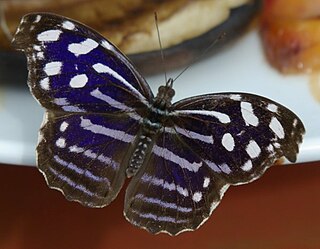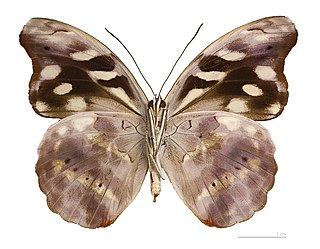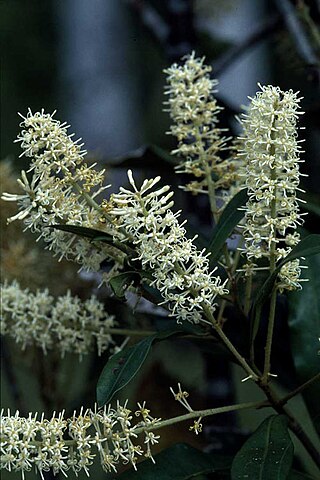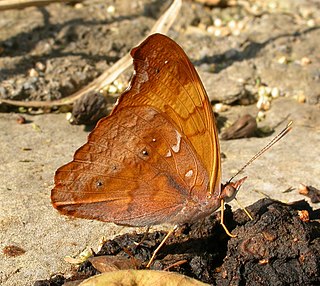
Swallowtail butterflies are large, colorful butterflies in the family Papilionidae, and include over 550 species. Though the majority are tropical, members of the family inhabit every continent except Antarctica. The family includes the largest butterflies in the world, the birdwing butterflies of the genus Ornithoptera.
Prickly ash may refer to:

Biblidinae is a subfamily of nymphalid butterflies that includes the tropical brushfoots. This subfamily was sometimes merged within the Limenitidinae, but they are now recognized as quite distinct lineages. In older literature, this subfamily is sometimes called Eurytelinae.

Catonephele is a nymphalid butterfly genus found in Mexico, Central America, South America, and the West Indies.
The Sticht Range is a mountain range located in the West Coast region of Tasmania, Australia. The range runs between two tributaries of the Eldon River and is located within the eastern part of the West Coast Range and has an unnamed peak with an elevation of 1,080 metres (3,540 ft) above sea level.

Orites excelsus, commonly known as prickly ash, mountain silky oak or white beefwood, is a species of flowering plant in the family Proteaceae and is endemic to eastern Australia. It is a medium-sized to tall rainforest tree with oblong to lance-shaped leaves, variously lobed and with teeth on the edges. The flowers are white and arranged in leaf axils in spikes that are shorter than the leaves.

Orites is a genus of nine plant species in the family Proteaceae − seven are endemic to Australia, one is endemic to the Chilean Andes and one to Bolivia.

Roupala is a Neotropical genus of woody shrubs and trees in the plant family Proteaceae. Its 34 species are generally found in forests from sea level to 4000 m altitude from Mexico to Argentina.

The fauna of Colombia is characterized by a high biodiversity, with the highest rate of species by area unit worldwide.

Orites lancifolius, commonly known as alpine orites, is a shrub in the family Proteaceae. It is endemic to south-eastern Australia. The species has a spreading habit and may be a prostrate or up to 2 metres high. The leaves are 1 to 3 cm long, and 5 to 12 mm wide. White to pale yellow flowers appear between December and January in its native range. The species was first formally described in 1855 by botanist Ferdinand von Mueller from plant material that he collected "on the rocky summits of the Australian Alps ".

Catonephele sabrina is a butterfly of the family Nymphalidae.

Orites revolutus , also known as narrow-leaf orites, is a Tasmanian endemic plant species in the family Proteaceae. Scottish botanist Robert Brown formally described the species in Transactions of the Linnean Society of London in 1810 from a specimen collected at Lake St Clair. Abundant in alpine and subalpine heath, it is a small to medium shrub 0.5 to 1.5 m tall, with relatively small, blunt leaves with strongly revolute margins. The white flowers grow on terminal spikes during summer. Being proteaceaous, O. revolutus is likely to provide a substantial food source for nectivorous animal species within its range.
Neorites is a monotypic genus of plants in the family Proteaceae. The sole species Neorites kevedianus, commonly called fishtail oak or fishtail silky oak, is a tall tree endemic to the wet tropics rainforests of north eastern Queensland, Australia.
Sphalmium is a monotypic genus of flowering plants in the protea family. The only species, Sphalmium racemosum, is a large forest tree. Common names include satin silky oak, mystery oak, Mt Lewis oak, poorman's fishtail oak and buff silky oak.

Nothorites is a monotypic genus in the macadamia family Proteaceae. The sole species, Nothorites megacarpus, is endemic to the wet tropics rain forests of northeastern Queensland, Australia.

Catonephele acontius, the Acontius firewing, is a nymphalid butterfly species found in South America. It was first described by Carl Linnaeus in 1771.

Orites diversifolia (=diversifolius), commonly known as variable orites, is a member of the family Proteaceae and is endemic to Tasmania. The common name stems from the variable form of the leaves, which range from entire and linear to serrated and ovate. It is a common shrub in lowland rainforest, subalpine woodland and scrub.

Orites acicularis, commonly known as yellow bush, is an angiosperm endemic to Tasmania, Australia and is a member of the genus Orites within the family Proteaceae. The species was first described in 1810 by Scottish botanist Robert Brown in Transactions of the Linnean Society of London.
Carniella orites is a species of comb-footed spider in the family Theridiidae. It is found in Thailand.

Temenis is a genus of butterflies in the family Nymphalidae, it consists of three species. It was first described by Jacob Hübner in 1819. Members of the genus Temenis are found throughout Central and South America.















